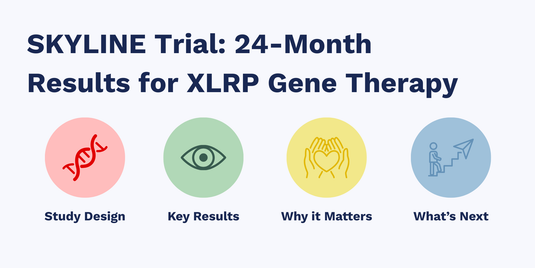At A Race Against Blindness, we are committed to following every development that brings hope to families living with rare retinal diseases. One exciting update came from the 2025 American Society of Retina Specialists (ASRS) annual meeting in Long Beach, California, where researchers shared encouraging results from the Phase 2 SKYLINE trial of a promising new therapy for X-linked retinitis pigmentosa (XLRP).
What is X-Linked Retinitis Pigmentosa?
XLRP is a rare, inherited retinal disease caused by mutations in the RPGR gene. It primarily affects males and leads to progressive vision loss, often beginning in childhood or adolescence. Over time, XLRP can cause severe blindness. Today, there are no FDA-approved treatments — which makes gene therapy research especially critical.
The SKYLINE Phase 2 Trial
The SKYLINE trial investigated laruzova, a full-length RPGR gene therapy designed to target the underlying genetic cause of XLRP.
Study Design
-
Participants: Males ages 8–50 with a confirmed RPGR mutation
-
Inclusion criteria: Measurable microperimetry sensitivity (a way of measuring how the retina responds to light) and a healthy foveal ellipsoid zone (a marker of photoreceptor health)
-
Goal: To evaluate dose-dependent effects and measure improvements in vision
Key Results at 24 Months
-
High-dose patients showed greater visual improvement compared to the low-dose group
-
Microperimetry response improved significantly in the high-dose group, suggesting better light sensitivity across the retina
-
Patients with more preserved retinal anatomy (especially a healthy ellipsoid band) were the most likely to benefit
These findings underscore the importance of identifying the optimal treatment window: patients must still have measurable vision loss to show improvement, but not so advanced that critical photoreceptors are lost.
Next Steps: The Phase 3 VISTA Trial
The pivotal Phase 3 VISTA trial is already fully recruited. Its two primary endpoints will measure:
-
Microperimetry sensitivity
-
Low luminance visual acuity (how well patients see in dim light)
If successful, this trial could pave the way toward FDA approval — and eventually, earlier intervention for patients at risk of vision loss.
Looking Ahead: A Future of Multiple Therapies
Dr. Robert A. Sisk, MD, FACS, FASRS, who presented the findings, expressed optimism that this is just the beginning. He envisions a future where patients with retinal diseases benefit from a combination of therapeutic strategies, including:
-
Gene augmentation therapy (like laruzova)
-
Gene-agnostic treatments that don’t depend on specific mutations
-
Stem cell studies to replace damaged photoreceptors
-
Optogenetic gene therapy for late-stage disease
The ultimate goal: comprehensive treatment approaches that protect and restore vision at every stage of disease progression.
Why This Matters
For families affected by XLRP — and for the broader rare retinal disease community — the SKYLINE results are a beacon of hope. They suggest that targeted gene therapies could slow or even reverse some aspects of vision loss, particularly when delivered at the right time.
At A Race Against Blindness, we’ll continue to follow these developments closely and share updates as the Phase 3 VISTA trial progresses. Every step forward brings us closer to a future where vision loss is no longer inevitable.
✅ Sources:
-
ASRS 2025 Presentation (Robert A. Sisk, MD, FACS, FASRS)
-
Ophthalmology Times coverage



